Classic Covers: Lighthouses
Why are we so fascinated by lighthouses? Is it because they are so picturesque? Or because, if they could talk, what exciting and harrowing tales of the sea they could tell? Whatever the reason, two Post cover artists — Mead Schaeffer and Stevan Dohanos — loved them as much as the rest of us.
Lighthouses by Stevan Dohanos
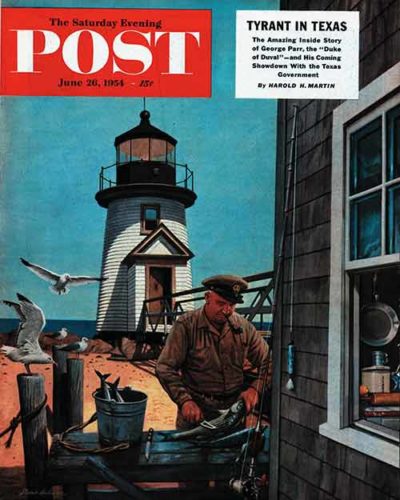
Lighthouse Keeper
by Stevan Dohanos
June 26, 1954
“Here a Coast Guard man,” Post editors wrote in 1954 of the cover above, “is adding to his duties the task of guarding coastal waters against getting too crowded with fish.” The ever-ravenous gulls await whatever tidbits they can make off with. The lighthouse was unidentified.
The candy striped tower (below) oversees a strait between the United States and Canada called Quoddy Narrows, looks much the same today as when Stevan Dohanos painted it in 1945.
The West Quoddy Light Keepers Association website fills us in on the intriguing history of this structure: The first tower, which was made of wood, “was built in 1808, by order of President Thomas Jefferson. The tower standing and operating today was built in 1857 and became operational in 1858.”
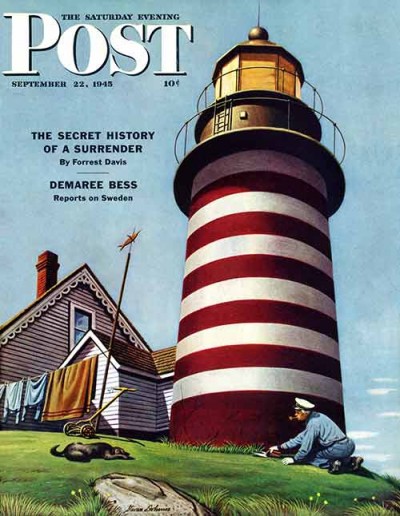
Lighthouse Keeper
by Stevan Dohanos
September 22, 1945
How did they illuminate the lighthouse in those days? The Light Keepers Association tells us it was “originally oil from sperm whales; to lard oil in the 1860s, to kerosene about 1880; to electricity in 1932.”
The artist took, well, artistic license, in painting this scene. Although the lighthouse was in Lubec, Maine, the lighthouse keeper trimming the grass was at Sankaty Light in Nantucket. Dohanos had made sketches of the striped West Quoddy lighthouse the year before, and because it was closer, went to the Sankaty Lighthouse to refresh his memory of the details. Turns out the Nantucket folks didn’t have much information on the Maine lighthouse. However, “they were cutting the grass at Sankaty Light,” editors noted, “and Dohanos liked that touch of domesticity or agriculture or whatever it is, so he included it.”
Mead Schaeffer’s Lighthouses
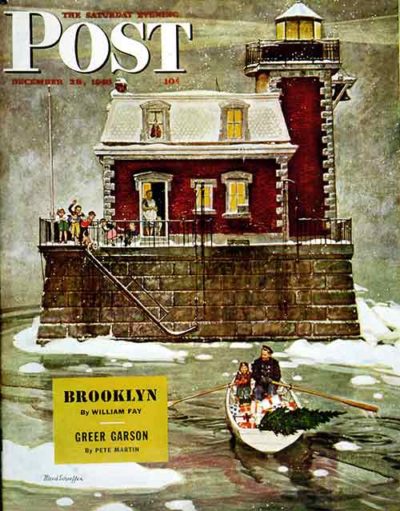
Christmas at the Lighthouse
Mead Schaeffer
December 28, 1946
Instead of resting on a strip of coastal land, this charming structure sits in the Hudson River between a town of the same name and Athens, on the other side. A large mud flat in the river stranded unsuspecting ships, so in 1873, construction began on the Hudson-Athens Lighthouse.
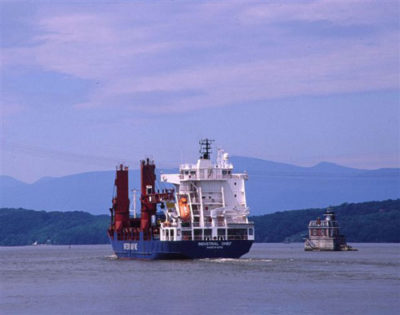
Today the lighthouse (at right) is an active aid to commercial ships and private boats in the Hudson River as it has been since 1874. (Photo courtesy of Hudson-Athens Lighthouse Preservation Society.)
The website for the Hudson-Athens Lighthouse Preservation Society includes floorplans and the history of the structure and its keepers. One of those, “Emil J. Brunner, kept the light from 1930 to 1949.” When Post cover artist Mead Schaeffer wanted to paint the scene, he asked Brunner and his family to pose.
“Artistic license allows for a dog (at the top of the steps),” writes Louise Bliss of the Preservation Society, “which was of course against Coast Guard rules, and there are too many children and there were no electric lights.” She’s right, the keeper and his wife had five children; the artist generously granted them eight. Intriguingly, Bliss noted, one of the little girls depicted, now grown of course, “comes to public tours in the summer and tells the tales of living on the lighthouse.”
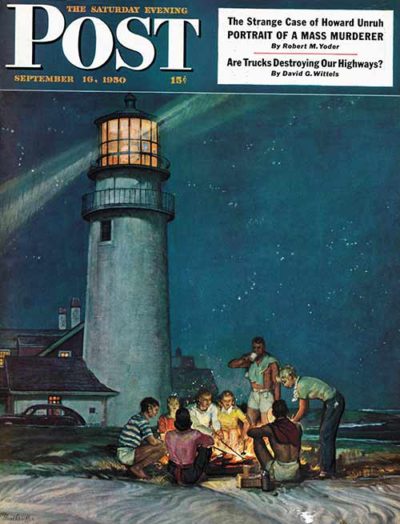
“Beach Bonfire”
by Mead Schaeffer
September 16, 1950
The cozy September scene (above) from 1950 is in Cape Cod, but there are perhaps 15 or so lighthouses on the Cape and the specific one was not identified. Perhaps a knowledgeable reader can let us know?